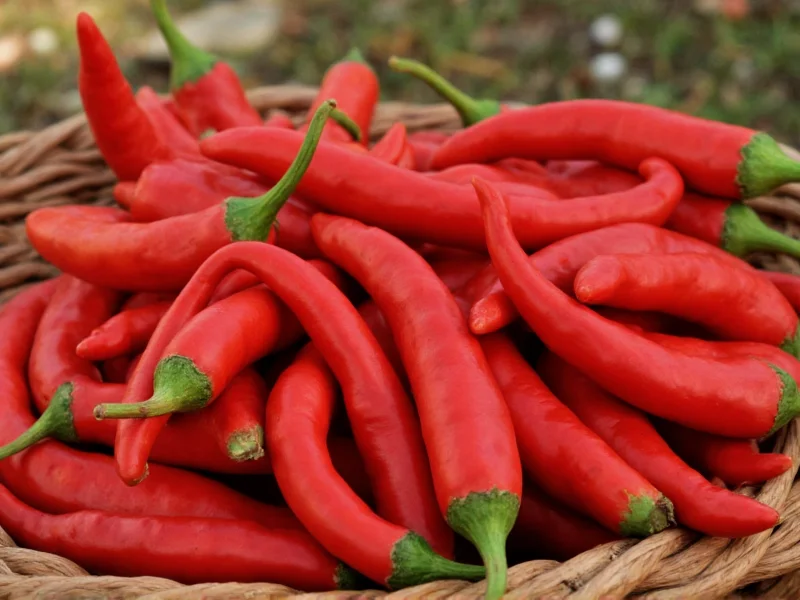Understanding the precise heat level of Chile de Arbol peppers is essential for both home cooks and culinary professionals. These slender, pointed peppers—known as “bird's beak” or “tree chili” in Spanish—deliver a clean, sharp heat that builds gradually rather than overwhelming the palate. Their consistent performance on the Scoville scale makes them a reliable choice for recipes requiring predictable spiciness.
Chile de Arbol Heat Characteristics
Unlike some chili varieties that show dramatic heat variations based on growing conditions, Chile de Arbol maintains relatively consistent Scoville measurements across different regions. The 15,000-65,000 SHU range represents laboratory-tested averages from multiple agricultural studies. When fresh, they typically land around 30,000-40,000 SHU, while dried versions often test at the higher end of the spectrum due to concentrated capsaicinoids.
Comparative Heat Scale Analysis
Understanding where Chile de Arbol falls among other common peppers provides valuable culinary context. The following table shows precise Scoville measurements for direct comparison:
| Pepper Variety | Scoville Heat Units (SHU) | Heat Level Classification |
|---|---|---|
| Chile de Arbol | 15,000 - 65,000 | Medium-Hot |
| Cayenne Pepper | 30,000 - 50,000 | Medium-Hot |
| Serrano Pepper | 10,000 - 23,000 | Medium |
| Jalapeño Pepper | 2,500 - 8,000 | Mild-Medium |
| Habanero Pepper | 100,000 - 350,000 | Very Hot |
| Ghost Pepper | 800,000 - 1,041,427 | Extremely Hot |
Practical Culinary Applications
The specific heat profile of Chile de Arbol makes them particularly valuable in Mexican cuisine. Their thinner walls and lower moisture content compared to cayenne peppers mean they dehydrate exceptionally well while maintaining flavor integrity. When using fresh Chile de Arbol, remove seeds and membranes to reduce heat by approximately 30-40%, as these contain the highest concentration of capsaicin.
Chefs appreciate Chile de Arbol for their distinctive flavor profile that extends beyond mere heat. They offer subtle nutty and smoky notes that develop beautifully when toasted before grinding. This characteristic makes them superior to cayenne in applications where flavor complexity matters, such as in traditional Mexican salsas and moles.
Handling and Safety Considerations
Working with Chile de Arbol requires proper handling techniques due to their significant capsaicin content. Always wear food-safe gloves when processing large quantities, and avoid touching your face or eyes. The heat compounds can remain active on surfaces for hours, so thorough hand washing with soap and water is essential after handling. If you experience skin irritation, apply milk or a specialized capsaicin removal product rather than water, which can spread the oil.
Storage and Preservation Methods
For maximum shelf life, store dried Chile de Arbol peppers in airtight containers away from light and moisture. Properly stored, they maintain potency for 1-2 years. Freezing fresh peppers preserves their heat characteristics better than refrigeration, which can cause moisture buildup and accelerate degradation. When grinding your own powder, use a dedicated spice grinder as residual heat compounds can affect future non-spicy preparations.
Substitution Guidance
If Chile de Arbol isn't available, cayenne pepper makes the closest substitute in terms of heat level, though it lacks the distinctive nutty flavor. For recipes where appearance matters, crushed red pepper flakes can work but typically deliver less consistent heat. When substituting, start with 75% of the recommended amount and adjust to taste, as heat levels between varieties can vary significantly.
Frequently Asked Questions
How does Chile de Arbol heat compare to cayenne pepper?
Chile de Arbol and cayenne peppers occupy similar ranges on the Scoville scale (15,000-65,000 SHU vs 30,000-50,000 SHU), but Chile de Arbol often tests hotter at the upper end. The key difference lies in flavor profile—Chile de Arbol offers more complex nutty notes while cayenne delivers a sharper, more straightforward heat.
Can I substitute Chile de Arbol for jalapeño in recipes?
Yes, but with significant adjustments. Chile de Arbol is approximately 5-15 times hotter than jalapeño peppers. When substituting, use only 1/4 to 1/2 the amount of Chile de Arbol compared to jalapeño, and consider removing seeds and membranes to reduce heat intensity while maintaining flavor.
Why do dried Chile de Arbol peppers seem hotter than fresh ones?
Drying concentrates the capsaicin compounds by removing water content. Fresh Chile de Arbol typically measures 30,000-40,000 SHU, while dried versions often test at 50,000-65,000 SHU. The dehydration process intensifies both heat and flavor, making dried peppers more potent by volume.
What's the best way to reduce Chile de Arbol heat in a dish?
Acidic ingredients like lime juice or vinegar can help counteract capsaicin's effects more effectively than dairy. For immediate relief while cooking, add small amounts of sugar or honey. If a dish becomes too spicy, incorporating starchy ingredients like beans or rice will help absorb excess heat without altering flavor profile significantly.
How long does the heat from Chile de Arbol last after consumption?
The burning sensation typically peaks within 2-5 minutes and gradually subsides over 15-30 minutes for most people. Unlike habaneros or ghost peppers, Chile de Arbol delivers a cleaner heat that doesn't linger excessively. Consuming dairy products like yogurt or milk can reduce the duration by binding with capsaicin molecules.











 浙公网安备
33010002000092号
浙公网安备
33010002000092号 浙B2-20120091-4
浙B2-20120091-4